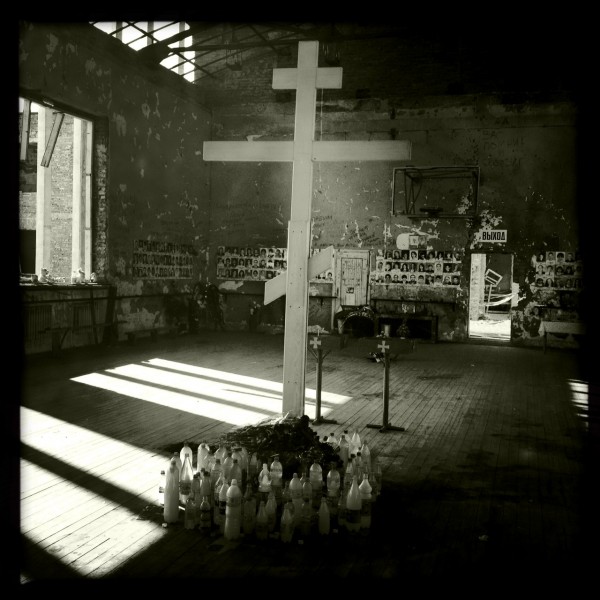UPDATE: The European Court of Human Rights has ruled that Russia is guilty of serious failings in the Beslan school siege in which about 330 people died in 2004. It says officials failed to take action to prevent the siege. The operation to end it and the investigation that followed were also strongly criticised. In the siege, Chechen rebels took more than 1,000 hostages, mostly children. It ended when Russian forces stormed the building. Survivors say the troops used excessive force. No Russian official has been held responsible for the high number of deaths, which included 186 children. MORE
WIKIPEDIA: The Beslan school hostage crisis (also referred to as the Beslan school siege or Beslan massacre)[2][3][4] of early September 2004 lasted three days and involved the capture of over 1,100 people as hostages (including 777 children),[5] ending with the death of over 380 people. The crisis began when a group of armed separatist militants, mostly Ingush and Chechen, occupied School Number One (SNO) in the town of Beslan, North Ossetia (an autonomous republic in the North Caucasus region of the Russian Federation) on 1 September 2004. The hostage-takers were the Riyadus-Salikhin Battalion, sent by the Chechen separatist warlord Shamil Basayev, who demanded an end to the Second Chechen War and Russian withdrawal from Chechnya. On the third day of the standoff, Russian security forces entered the building with the use of tanks, incendiary rockets and other heavy weapons.[6] At least 334 hostages were killed as a result of the crisis, including 186 children,[7][8] with a significant number of people injured and reported missing.
The event led to security and political repercussions in Russia, most notably a series of federal government reforms consolidating power in the Kremlin and strengthening of the powers of the President of Russia.[9] According to American non-governmental organization (NGO), Freedom House, these reforms consolidated Russia as a politically non-free, authoritarian state since the mid-2000s.[10][11] As of 2011, aspects of the crisis in relation to the militants remain contentious; including how many militants were involved, the nature of their preparations and whether a section of the group had escaped. Questions about the Russian government’s management of the crisis have also persisted; including allegations of disinformation and censorship in news media, whether the journalists who were present at Beslan were allowed to freely report on the crisis,[12] the nature and content of negotiations with the militants, allocation of responsibility for the eventual outcome, and perceptions that excessive force was used.[6][13][14][15][16]
ESQUIRE: The place was a horror. Each element of the siege — from the capture of the children to the enforced conditions of their captivity among the bombs to the murders of their fathers and teachers in the literature classroom to the explosions that ripped apart people by the score — had been a descent deeper into cruelty, violence, and near-paralyzing fear. Now they had reached the worst. Women stood at windows, screaming and waving white cloths. Bullets struck the walls. Dust and smoke hung in the air. Glass covered the floor, much of it splattered with blood. The room stunk of gunpowder, rotting food, and sweat. Terrorists raced through the haze, bearded, whooping, firing, and yelling instructions. Larisa had her son, Zaurbek, by the hand, and apprehended their new conditions; Madina had the two children she had brought from the weight room. She did not know their names. They rushed around a corner near the dish-washing room, where at least twenty other hostages were massed tight. Two girls were trying to squeeze themselves into a massive soup pot. Dead women and children were strewn on the kitchen tiles. The Kudziyeva family took a place on the floor. […]
Less than fifteen minutes after Irina Naldikoyeva and her son found refuge in the auditorium, the terrorists forced them downstairs to the cafeteria and its tableau of misery. Hostages crowded the room, partially dressed, soiled, riddled with shrapnel, shot, burned, dehydrated, and stunned. Irina saw her niece, Vika, slumped beneath a window, her long black hair matted with sweat. “Where is Alana?” she asked. “Here,” Vika said, pointing to a child, naked except for dirty panties, curled under a table. Bullets were coming in from the Russians firing outside. Irina grabbed her children and scrambled with them along the floor, stopping against a large freezer, panting. A terrorist handed her a bucket of water, and she tilted it and gave each child a drink. They gulped voraciously. At last it was her turn, and she put the bucket to her lips, poured the cool water onto her tongue, eager for it to hit her parched throat. But instead the water splashed onto her floral blouse. Irina did not understand and reached under her chin and felt the place where shrapnel had passed through. The bottom of her mouth was an open hole. Blood and water soaked her torso. She put the bucket aside. Around her were at least six dead children, and she knew this place was not safe. She crawled to the dish-washing room, pushed the children under the sinks, and lay her body across them. Bullets kept coming. Some skipped off window frames or iron bars and whirred by, ricochets. MORE
RELATED: Timeline Of The Beslan School Hostage Crisis
48 HOURS: While working in Beslan, filmmakers were given a remarkable tape discovered by teenagers in the rubble of the school after the siege. A video camera brought to school that September morning by a proud Beslan parent, found its way into the hands of the terrorists. The tape reveals never-before-seen details of the drama unfolding inside the besieged school. The video lets us see, first hand, the absolute horror of the takeover, including a pile of bodies dumped out of a classroom window after having been shot by the terrorists on the first day. MORE

